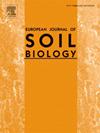Microbial mechanism of soil organic carbon content under waterlogging and water table fluctuation in drained peat soils
IF 3.3
2区 农林科学
Q1 ECOLOGY
引用次数: 0
Abstract
Peatlands serve as crucial reservoirs within the global carbon cycle; however, widespread degradation has led to significant reductions in soil organic carbon (SOC) contents. The effects of rewetting on the active SOC and the underlying microbial mechanisms in degraded peatlands are still not fully elucidated. This study examined changes in bulk and active SOC contents, as well as microbial community composition and enzyme activities via controlled water table (WT) manipulation in intact peat columns sourced from drained sites in the Changbai Mountains. The results demonstrated that variations in WT significantly influenced microbial biomass and enzymatic activities within the surface soil layer. Waterlogging resulted in decreased total bacterial and actinomycete biomass, accompanied by a marked increase in fungal biomass, especially under WT fluctuation. Soil oxidase and hydrolase activities only increased significantly under WT fluctuation treatments. SOC contents rose under waterlogged conditions but declined with WT fluctuation. Both dissolved organic carbon (DOC) and microbial biomass carbon were elevated in surface soils subjected to waterlogged and WT fluctuation compared to those in drained peat. However, the easily oxidizable carbon contents were only elevated in surface soils subjected to waterlogged treatments compared to those in drained peat. Soil moisture content had the greatest positive influence, while pH had the greatest negative influence on SOC contents. Actinomycete and DOC had negative impacts on SOC contents under varied WT conditions. This study clarifies the regulatory influence of WT on microbial community dynamics and enzyme activities relevant to SOC storage in degraded peatlands, highlighting the importance of WT management for effective peatland restoration.
涝渍和地下水位波动对排干泥炭土土壤有机碳含量的微生物机制
泥炭地是全球碳循环的重要储存库;然而,广泛的退化导致土壤有机碳(SOC)含量显著降低。复湿对退化泥炭地活性有机碳的影响及其潜在的微生物机制尚不完全清楚。通过控制地下水位(WT)的方法,研究了长白山干枯土壤中完整泥炭柱的有机碳含量、活性有机碳含量、微生物群落组成和酶活性的变化。结果表明,WT的变化对土壤表层微生物生物量和酶活性有显著影响。涝渍导致细菌和放线菌总生物量下降,真菌生物量显著增加,尤其是在WT波动下。土壤氧化酶和水解酶活性仅在WT波动处理下显著增加。土壤有机碳含量在淹水条件下呈上升趋势,但随WT波动而下降。受涝渍和WT波动影响的表层土壤溶解有机碳(DOC)和微生物生物量碳均高于排水泥炭。然而,与排水泥炭相比,淹水处理仅使表层土壤的易氧化碳含量升高。土壤含水量对有机碳含量的正向影响最大,pH对有机碳含量的负向影响最大。放线菌和DOC对土壤有机碳含量有负向影响。本研究阐明了WT对退化泥炭地微生物群落动态和与有机碳储量相关的酶活性的调控作用,强调了WT管理对有效恢复泥炭地的重要性。
本文章由计算机程序翻译,如有差异,请以英文原文为准。
求助全文
约1分钟内获得全文
求助全文
来源期刊

European Journal of Soil Biology
环境科学-生态学
CiteScore
6.90
自引率
0.00%
发文量
51
审稿时长
27 days
期刊介绍:
The European Journal of Soil Biology covers all aspects of soil biology which deal with microbial and faunal ecology and activity in soils, as well as natural ecosystems or biomes connected to ecological interests: biodiversity, biological conservation, adaptation, impact of global changes on soil biodiversity and ecosystem functioning and effects and fate of pollutants as influenced by soil organisms. Different levels in ecosystem structure are taken into account: individuals, populations, communities and ecosystems themselves. At each level, different disciplinary approaches are welcomed: molecular biology, genetics, ecophysiology, ecology, biogeography and landscape ecology.
 求助内容:
求助内容: 应助结果提醒方式:
应助结果提醒方式:


